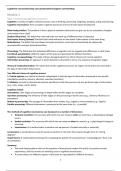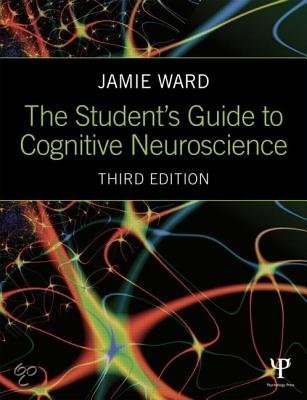Cognitieve neurowetenschap voor geesteswetenschappers samenvatting
Module 1
Ward H1 Introducing cognitive neuroscience
Cognition: A variety of higher mental processes such as thinking, perceiving, imagining, speaking, acting and planning
Cognitive neuroscience: Aims to explain cognitive processes in terms of brain-based mechanisms
Mind–body problem: The problem of how a physical substance (the brain) can give rise to our sensations, thoughts
and emotions (our mind)
Dualism (Descartes): The belief that mind and brain are made up of different kinds of substance
Dual-aspect theory (Spinoza):The belief that mind and brain are two levels of description of the same thing
Reductionism: The belief that mind-based concepts (emotions, memories) will eventually be replaced by
neuroscientific concepts (neurotransmitter)
Phrenology: The failed idea that individual differences in cognition can be mapped onto differences in skull shape
Functional specialization: Different regions of the brain are specialized for different functions
Cognitive neuropsychology: The study of brain-damaged patients to inform theories of normal cognition
Information processing: An approach in which behavior is described in terms of a sequence of cognitive stages
Theory of modularity (Fodor): The notion that certain cognitive processes (or regions of the brain) are restricted in
the type of information they process
Two different classes of cognitive process:
1. Central systems: are held to be domain independent in that the type of information processed is non-specific
(candidates would be memory, attention, executive functions)
2. Modules: are held to demonstrate domain specificity in that they process only one particular type of information
(e.g., color, shape, words, faces)
Cognitive models
Interactivity: Later stages of processing can begin before earlier stages are complete.
Top-down processing: The influence of later stages on the processing of earlier ones (e.g., memory influences on
perception)
Bottom-up processing: The passage of information from simpler (e.g., edges) to more complex (e.g., objects)
Parallel processing: Different information is processed at the same time (i.e., in parallel)
The methods of cognitive neuroscience can be placed on a number of dimensions
• Temporal resolution: The accuracy with which one can measure when an event (e.g., a physiological change)
occurs
• Spatial resolution: The accuracy with which one can measure where an event (e.g., a physiological change) is
occurring
• Invasiveness: of a method refers to whether the equipment is located internally or externally
Connectome: A comprehensive map of neural connections in the brain that may be thought of as its “wiring
diagram.”
Graph theory: A mathematical technique for computing the pattern of connectivity (or “wiring diagram”) from a set
of correlations
Summary:
• The mind–body problem refers to the question of how physical matter (the brain) can produce mental
experiences, and this remains an enduring issue in cognitive neuroscience.
• To some extent, the different regions of the brain are specialized for different functions.
1
, • Functional neuroimaging has provided the driving force for much of the development of cognitive
neuroscience, but there is a danger in merely using these methods to localize cognitive functions without
understanding how they work.
• Cognitive psychology has developed as a discipline without making explicit references to the brain. However,
biological measures can provide an alternative source of evidence to inform cognitive theory and the brain
must provide constraining factors on the nature and development of the information-processing models of
cognitive science.
• Attempting to map the human connectome, and link it to cognition, is the greatest challenge for the next
generation of cognitive neuroscientists. Although old concepts will remain (e.g., the idea of functional
specialization), they may be understood in entirely new ways.
Kennisclip We zijn dieren
1. We zijn dieren!
2. We zijn net als andere dieren ‘wandelende gereedschapskisten’ met allerlei biologisch geëvolueerde
eigenschappen (biologische adaptaties) die ons in onze ‘niche’ helpen te overleven en ons voort te planten
3. We delen een flink deel van dat gereedschap met heel veel andere dieren (basic vertebrate body plan →
skelet, visueel perceptiesysteem, geheugen, emotie)
4. We hebben ook een aantal relatief of zelfs volledig unieke ‘tools’ (handige handen, taalvermogen, cultuur)
Wat kan je zoal doen om niet ten onder te gaan? (Sean Carroll)
• Get bigger
• Get armor
• Get out of the way
• Get smarter
- Wordt beter in het representeren(map-making) van je omgeving en jezelf
- Zorg voor executive control zodat je geen slaaf ben van evolutionaire reflexen
- Ga samenwerken, cmmuniceren, vastleggen, er over lesgeven
Het brein = niks meer dan een verzameling lichaamscellen die zich is gaan specialiseren in informatieverwerking
Ward H2 Introducing the brain
Neuron: A type of cell that makes up the nervous system and supports, among other things, cognitive function
Cell body: Part of the neuron containing the nucleus and other organelles
Dendrites: Branching structures that carry information from other neurons
Axon: A branching structure that carries information to other neurons and transmits an action potential.
Synapse (pre and postsynaptic neurons): The small gap between neurons in which neurotransmitters are released,
permitting signaling between neurons
Action potential: A sudden change (depolarization and repolarization) in the electrical properties of the neuron
membrane in an axon, which forms the basis for how neurons code information (in the form of the rate and
synchrony of action potentials)
Neurotransmitters: Chemical signals that are released by one neuron and affect the properties of other neurons
Myelin: A fatty substance that is deposited around the axon of some neurons that speeds conduction.
Glia: Support cells of the nervous system involved in tissue repair and in the formation of myelin (among other
functions)
2
, Gray matter: Consisting primarily of neuronal cell bodies, dendrites and axons
White matter: Tissue of the nervous system consisting primarily of axons and support cells
Cerebral cortex → beneath the white matter → the subcortex
L: There are three different kinds
of white matter tract, depending
on the nature of the regions that
are connected.
The subcortex is typically divided into a number of different systems with different evolutionary and functional
histories:
• Basal ganglia: Regions of subcortical gray matter involved in aspects of motor control, skill learning and
reward learning; they consist of structures such as the caudate nucleus, putamen and globus pallidus.
• Limbic system: A region of subcortex involved in relating the organism to its present and past environment;
limbic structures include the amygdala (detection of fearful or threatening stimuli), hippocampus (learning
and memory), cingulate cortex (detection of emotional and cognitive conflicts) and mamillary bodies
(memory)
• Diencephalon:
- Thalamus: A major subcortical relay center; for instance, it is a processing station between all sensory
organs (except smell) and the cortex
• Hypothalamus: Consists of a variety of nuclei that are specialized for different functions that are primarily
concerned with the body and its regulation
Corpus callosum: A large white matter tract that connects the two hemispheres
Ventricles: The hollow chambers of the brain that contain cerebrospinal fluid
Gyri (gyrus = singular): The raised folds of the cortex
Sulci (sulcus = singular): The buried grooves of the cortex
Cerebrospinal fluid (CSF): carries waste metabolites, transfers some messenger signals and provides a protective
cushion for the brain
There are four different ways in which regions of cerebral cortex may be divided and, hence, labeled:
3






